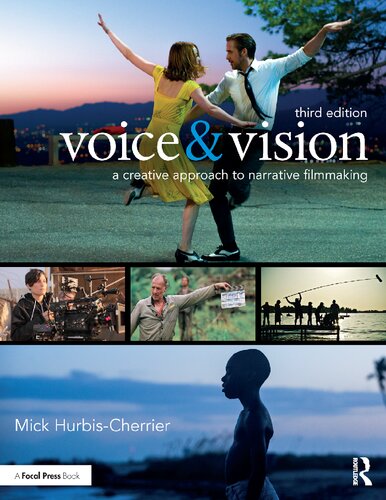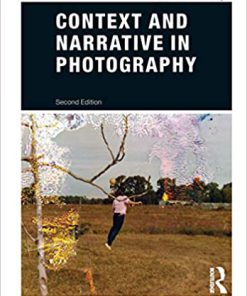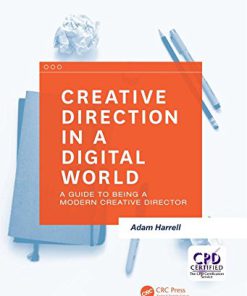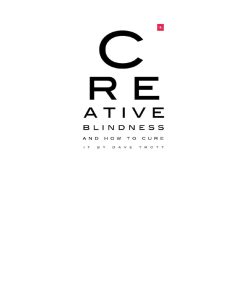Voice Vision A Creative Approach to Narrative Filmmaking 3rd Edition by Mick Hurbis Cherrier 9780415739986 0415739985
$50.00 Original price was: $50.00.$25.00Current price is: $25.00.
Voice Vision A Creative Approach to Narrative Filmmaking 3rd Edition by Mick Hurbis Cherrier – Ebook PDF Instant Download/Delivery:9780415739986 ,0415739985
Full download Voice Vision A Creative Approach to Narrative Filmmaking 3rd Edition after payment
Product details:
ISBN 10: 0415739985
ISBN 13: 9780415739986
Author: Mick Hurbis Cherrier
Develop your creative voice while acquiring the practical skills and confidence to use it with this new and fully updated edition of Mick Hurbis-Cherrier’s filmmaking bible, Voice & Vision. Written for independent filmmakers and film students who want a solid grounding in the tools, techniques, and processes of narrative film, this comprehensive manual covers all of the essentials while keeping artistic vision front and center. Hurbis-Cherrier walks the reader through every step of the process—from the transformation of an idea into a cinematic story, to the intricacies of promotion and distribution—and every detail in between. Features of this book include: Comprehensive technical information on video production and postproduction tools, allowing filmmakers to express themselves with any camera, in any format, and on any budget An emphasis on the collaborative filmmaking process, including the responsibilities and creative contributions of every principal member of the crew and cast A focus on learning to work successfully with available resources (time, equipment, budget, personnel, etc.) in order to turn limitations into opportunities Updated digital filmmaking workflow breakdowns for Rec. 709 HD, Log Format, and D-Cinema productions Substantial coverage of the sound tools and techniques used in film production and the creative impact of postproduction sound design An extensive discussion of digital cinematography fundamentals, including essential lighting and exposure control tools, common gamma profiles, the use of LUTs, and the role of color grading Abundant examples referencing contemporary and classic films from around the world Indispensible information on production safety, team etiquette, and set procedures. The third edition also features a robust companion website that includes eight award-winning example short films; interactive and high-resolution figures; downloadable raw footage; production forms and logs for preproduction, production, and postproduction; video examples that illustrate key concepts found within the book, and more. Whether you are using it in the classroom or are looking for a comprehensive reference to learn everything you need to know about the filmmaking process, Voice & Vision delivers all of the details in an accessible and reader-friendly format.
Voice Vision A Creative Approach to Narrative Filmmaking 3rd Table of contents:
Part I ■ Developing Your Film on Paper
Chapter 1: From Idea to Cinematic Story
Finding an Idea
From an Idea to a Story
Narrative Basics I: Essential Story Elements
The Central Character
The Dramatic Situation: Conflict, Action, and the Central Question
Story Dynamism: Action, Change, and Development
The Stakes
Resolution and Meaning
Story Essentials in Practice
Making Specific Choices
Narrative Basics II: Goal and Conflict-Driven Stories
Narrative Basics III: Other Dramatic Story Concepts
A Final Note on Essential Dramatic Principles
Ideas within Limitations
Story Scale and Film Length
Production Time
Financial Resources
Equipment, Location, Props, and Other Resources
Cast and Crew
Keep It Manageable
Chapter 2: The Screenplay
Stages of Script Development
Concept
Treatment
Author’s Draft to Final Draft
Shooting Script
Formatting the Author’s Draft Screenplay
Elements of an Author’s Draft Script
Screenplay Language and Style
Visual Writing, Character, and Action
Working with Dialogue: Revealing Emotions, Not Announcing Them
Reworking and Rewriting
Chapter 3: The Visual Language and Aesthetics of Cinema
Shots, Sequences, and Scenes
The Frame and Composition
Dimensions of the Frame
Shot Composition and the Graphic Qualities of the Frame
Shot Size
Camera Angles
The Moving Frame
Camera Moves
The Moving Frame and Perspective
Motivation and the Moving Camera
Rate of Motion
Slow Motion
Fast Motion
Conclusion
Chapter 4: Organizing Cinematic time and Space
Single-Camera Production and the Continuity System
Principles of Continuity Style
Continuity of Mise-en-Scène
Continuity of Sound
Continuity of Performance, Actions, and Placement
Spatial Continuity and the 180° Principle
20mm/30° Rule
Cutting on Action
Scene Strategies: Putting Continuity to Use
Two-Person and Person/Object Interactions
Changing the Line of Action
Creating Visual Point of View
Group Interactions
Moving a Person through Space
Moving People through Space: Following or Converging
Parallel Action Sequence
Cheating on Film
Style Outside the Continuity System
Jump Cut Technique
Long Take Technique
Chapter 5: From Screenplay to Visual Plan
Three Tools for Previsualization
The Shooting Script
Overhead Diagrams
Storyboards
It’s Only on Paper, Not Written in Stone
The Director and Previsualizing: A Method
The Big Picture
The Details: How to Cover Scenes
Back to the Big Picture
Previsualization and Collaboration
Director and Cinematographer
Director and Actors
Director and Production Team
The Shot List: From Visual Plan to Production Plan
Creating a Shot List
Day-to-Day Production Scheduling
Part II ■ Preparing for Production
Chapter 6: Preparing for Production
Line Producing and the Creative Process
How Much is Enough?
Production Design
Locations and Set Dressing
Location Scouting
The Location Technical Survey
Wardrobe and Props
The Script Breakdown
Budgeting Your Film
Shooting Days: Film Length, Scale, and Shooting Ratio
Workflow and Budgeting
Department Structure
Equipment and Facilities
Supplies, Materials, and Expendables
Location Expenses
Personnel (Cast and Crew)
Legal and Insurance
Hidden Costs and Contingency
Feature-Film Budgets
Summary: Preproduction Paperwork
Chapter 7: The Cast and Crew
The Production Crew
Production Department Structure
Departments and Department Heads: The Creative Core
The Producing Team
The Director, Assistant Director, and Script Supervisor
The Camera and Electric Departments
The Art Department
The Sound Department
The Appropriate Crew Size
Crew Meetings and Communication
Being a Crewmember
On-Camera Talent
Finding an Actor
Auditions
Callbacks
Releases, Minors, and Unions
Actors Unions
Working with Actors I: Before the Camera Rolls
The Actor as Creative Collaborator
Rehearsals
Working with Trained Actors
Working with Nonactors
Working with Extras
The Contact Sheet
Part III ■ Tools and Techniques: Production
Chapter 8: The Digital Video System
Film: A Mechanical and Photochemical Medium
Video: An Electronic Medium
Analog versus Digital Video
Video Formats
Broadcast Standards
Scanning and Frame Rate
Aspect Ratio
Resolution
Color Encoding: Rec. 709 and Rec. 2020
Timecode
Other Broadcast Standards Worldwide
DCI Standards for Theatrical Projection
A Final Note on Video Standards
Chapter 9: The Digital Video Camera
Digital Video Camera Essentials: Exterior
The Body
Function Buttons and Switches
The Lens
Servo Zoom Control
Viewfinders and LCD Viewscreens
Media Bay
Video, Audio, Data-In and Out
DC Power
Digital Video Camera Essentials: Interior
The Image Sensor
Analog-to-Digital Converter
The Digital Signal Processor
Compression and Codecs
Chroma Subsampling
Data Rate
Camera Settings
Format Settings
Image Control Settings
Digital Video Cameras Today
The Camcorder
DSLRs and Mirrorless Cameras
Hybrid Large Sensor Cameras
Action Cams
The Ultra High End: D-Cinema, UHD, and Beyond
How Much Camera Do You Actually Need?
The Future
Chapter 10: The Camera Lens
Basic Lens Optics
Focal Length
Prime and Zoom Lenses
Crop Factor: Focal Length and Sensor Size
Lens Perspective
Focus
Selective Focus
Methods for Finding Focus
Aperture
F-stops and T-stops
Aperture and Exposure Control
Lens Speed
Automatic versus Manual Lens Functions
Depth of Field
Controlling Depth of Field
DOF Range Distribution
Circle of Confusion
Chapter 11: Camera Support
The Handheld Camera
Shoulder Mounts
The Tripod
Tripod Head
Tripod Legs
The Dolly
Sliders
Jib Arms
Stabilizing Systems
Jerry-Rigged or Improvised Support Systems
Drones
Aesthetic and Practical Considerations
Camera Moves versus Camera Adjustments
Chapter 12: Basics of Exposure
Image Exposure
Elements of Exposure
Finding Exposures with In-Camera Meters
The Run ‘n’ Gun Exposure Method
The Gray Card Exposure Method
Zoom versus Spot Meter Function
Which Exposure?
More Metering Options
Black, White, and Middle Gray: A Waveform Monitor Introduction
Zebras
Using Field Monitors
Chapter 13: Basics of Light and Lighting
The Fundamental Objectives of Lighting
The Fundamental Sources of Light
Three Essential Properties of Light
Intensity
Quality
Color Temperature
Light and Directionality
Fundamental Lighting Setups and Principles
Key Light
Fill Light
Backlight
Set Lights
Specials and Practicals
Three-Point Lighting
Lighting Order and Exposures
Lighting Ratios
Background-to-Subject Ratio
Exterior Lighting
Location Scouting and Scheduling
Check the Weather
Subject and Camera Positions
Sun Plus Bounced Light
Shade Plus Bounced Light
Diffusing Sunlight
Dusk-for-Night
Shooting at Night
Magic Hour
Altering Light with Gels and Filters
Lighting Gels
Camera Filters
Basic Lighting and Grip Equipment
Lighting Units
Basic Grip Gear
Chapter 14: Lighting and Exposure: Beyond the Basics
Contrast Range and Dynamic Range
Contrast Range
Dynamic Range
Video Gamma
Gamma Options
Dynamic Range versus Useable Dynamic Range
Advanced Exposure Tools
Handheld Light Meters
The Waveform Monitor
Putting Dynamic Range, Exposures, and Lighting to Work
Reflectance and Exposure Range
Camera Tests
Don’t Forget What It’s All About
Lighting Approaches and Styles
Naturalism and Lighting
Stylized Lighting
Not an Either/or Choice
Finding the Appropriate Lighting Strategy
The Overall Look
Visual Research
Other Considerations
A Final Word on Cinematography
Chapter 15: Sound for Production
What is Production Audio?
Understanding Sound
Frequency (Pitch)
Amplitude (Loudness)
Quality (Timbre)
Velocity
Production Sound
Location Audio: Sync Sound, Wild Sound, and Ambient Sound
Location Acoustics
Double-System and Single-System Recording
Why Double-System for Narrative Projects?
The Slate in Double-System Recording
Digital Sound Recording
The Basic Signal Path
Digital Audio: Quality Matters
Sampling, Bit Depth, and File Formats
Production Sound Tools
The Digital Sound Recorder
Sound Recording Direct to Camera
Portable Field Mixers
Microphones
Dynamic, Condenser, and Electret Condenser
Microphone Frequency Response
Microphone Directionality
The XLR Connector
Wireless and On-Board Microphones
What’s Really Important
Chapter 16: Location Sound Techniques
The Sound Team
Sound Preproduction
Recording Technique
Setting Levels
Reference Tone and Calibration
Manual versus Automatic Functions
Headphone Monitoring
Microphone Technique
Selecting the Right Microphone
Balance, Consistency, and Being On-Axis
Booms and Boom Technique
Using Lavaliere Mics
Miking and Perspective
Using Multiple Microphones
Ambient Sound and Audio Continuity
Miscellaneous Recording Challenges
Chapter 17: On-Set Procedures
Walking Onto the Set
Who Does What, When
Dressing the Set
Loading In
Prepping the Gear and Rough Setup
Tech Rehearsal
Setup
Final Run-Throughs
Shooting a Take
Slate Protocol
Evaluating the Take
Additional Shooting Procedures
Time Management
The Script Supervisor’s Report
Data Management
File-Based Media Management on the Set
The Data Wrangler’s Kit
The Data Backup Process
Data Organization
After the Shoot
Striking the Set
That’s a Wrap!
The Director and Actors On the Set
Tech Rehearsals
Setup
Run-throughs
Takes
Flexibility and Opportunities
Chapter 18: Set Etiquette and Production Safety
Set Etiquette: Respect, Courtesy, and Good Work
Food and Breaks
Courtesy on Public Locations
Respect and Protect the Locations, Props, and Costumes
Respect Your Equipment
Production Safety and Security
Prepare for Safety
Production Insurance
Common Sense
Locations and Permits
Rest and Health
Weather
Risky Locations
Picture Vehicles and Drones
Weapons and Violence
Fire and Open Flames
Water
Physical Stunts
Security
Electricity and Safety
How Much Electricity?
Electrical Loads and Time
Lighting and Grip Safety Tips
Part IV ■ Tools and Techniques: Postproduction
Chapter 19: Postproduction Overview: Workflow and the Editing Stages
The Postproduction Team
Technical Workflow: From Start to Finish
Low-Budget Workflows
Format Workflow: Codecs and Containers
LUTs and Workflow
High-End Workflow
Any Film Can Distribute as a DCP
The Editing Stages
Edit Process Overview
Viewing Dailies
First Assembly Edit
Rough Cuts
Fresh Eyes and Review Screenings
Cutting Dialogue
The Fine Cut and Picture Lock
Finishing
Mastering
Chapter 20: Digital Editing Fundamentals
Too Much of a Good Thing?
How to Approach Surplus Technology
The Basic NLE System
The Hardware Setup
The Software Interface
Editing Essentials I: Getting Started
Setting Up Your NLE Project
Importing Video and Audio Assets
Syncing Footage
Organizing Your Footage
Using Bins to Organize
Editing Essentials II: Making Simple Edits
Basic Edit Types
Basic Cutting
Think!
Chapter 21: The Art and Technique of Editing
The Golden Rule of Postproduction
Why We Edit I: Narrative Order and Emphasis
Editing for Story Order
Editing for Dramatic Emphasis
Fundamental Image-to-Image Transitions
The Cut
The Dissolve
The Fade
Why We Edit II: Extra-Narrative Considerations
Temporal Editing: Condensing and Expanding Time
Timing, Rhythm, and Pace
Associative Editing
Emotion
Chapter 22: The Sound Design in Film
Sound Design Overview
Sound Design I: Sounds, Sync, and Source
Movie Sounds: Speech, Sound Effects, Ambience, and Music
Synchronous, Nonsynchronous, and Postsynchronous Audio
Source
Sound Design II: The Sound Elements in Detail
Speech
Sound Effects—Hard and Soft
Ambient Sound, Room Tone, and Walla
Music
Common Music Pitfalls
Sound Design Strategies
From Realism to Stylized Approaches
Chapter 23: Cutting Sound and Working with Multiple Tracks
Working with Multiple Tracks
Building Your Essential Audio Tracks
Refining Your Sound Design
Tweaking Sound and Using Workspaces
Sound Track Labels by Type
Basic Sound Design: Analysis of a Simple Scene
Dialogue Tracks
Room Tone Track
Sound Effects Track
Ambience Track
Music Track
The Sound Mix
The Sound Mixing Steps
Step 1: Final Sound Selection, Placement, and Splitting Tracks
Step 2: Audio Sweetening
Step 3: Creating Audio Transitions
Step 4: Audio Level Balancing
Step 5: The Mix Down
Advanced Sound Mixing Programs
Why Go Pro?
Chapter 24: Grading, Mastering, and Distribution
Color Correction versus Color Grading
Basic Color Correction in Your NLE
Adjusting Luminance Values
Adjusting Chrominance Values
The Color Workspace and Tools
Grading Log Footage From Scratch
Applying LUTs to Log Footage
Advice from the Color Grading Trenches
Titles and Credits
Mastering and Distribution Copies
Output Formats for Distribution
DVD and Blu-Ray
Distributing Your Film
Self-Distribution
Distributors
Film Festivals
Traditional Theatrical
Crowdsource Theatrical
Digital: Video Hosting/Sharing
Digital: Video on Demand
Recommended Readings
Recommended Filmmaking Apps For Mobile Devices
Bibliography
Filmography
Photo And Illustration Credits
People also search for Voice Vision A Creative Approach to Narrative Filmmaking 3rd :
voice & vision a creative approach to narrative filmmaking pdf
borrow voice & vision a creative approach to narrative filmmaking
what is narrative filmmaking
visual narrative in film
voice-over narration is considered postmodern when
Tags:
Mick Hurbis Cherrier,Approach,Voice,Filmmaking,Creative
You may also like…
Politics & Philosophy - Anthropology
Context and Narrative in Photography Basics Creative Photography 2nd Edition Maria Short
Psychology - Cognitive Psychology
Cognition and Emotion From Order to Disorder 3rd Edition Mick Power 1317483782 9781317483786
Arts - Business of Art
Science (General)
Relationships & Lifestyle - Aging
Jurisprudence & Law - Intellectual Property
The Analysis Of Legal Cases A Narrative Approach Flora Di Donato
Business & Economics












